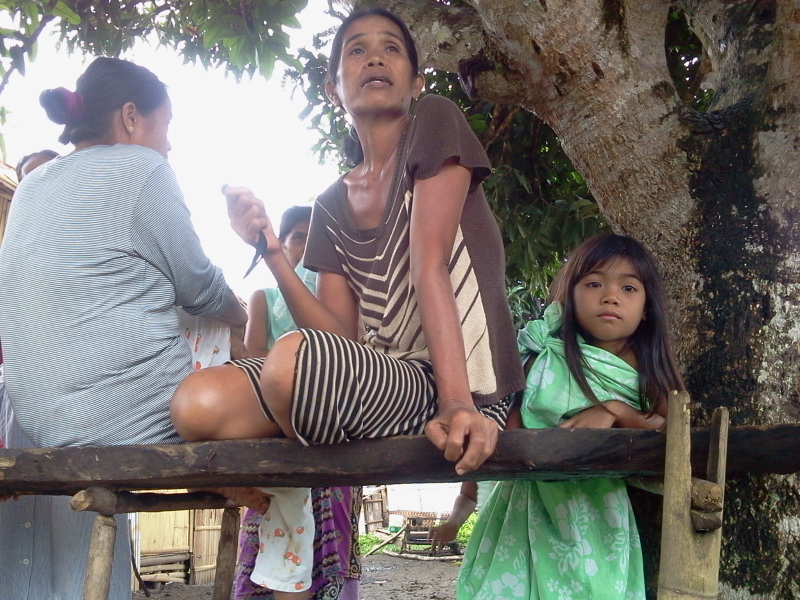By JOHNNA VILLAVIRAY GIOLAGON
BAGA-IR Panaggulan was on his boat that sunny day of Sept. 8, 2008, fishing in the Pulangi River in Bukidnon in Mindanao when he saw a boatload of soldiers armed for combat.
Clashes between the military and Moro Islamic Liberation Front (MILF) forces were fierce at the time. It was inevitable that hostilities reached Barangay Tee in Datu Piang, Maguindanao where Baga-ir lived.
Baga-ir, then 28, hurriedly paddled to shore. He asked his wife Zaida to pack their clothes and get ready to run.
The couple joined relatives on a motorized banca and fled to the highway in Bgy. Butilen. They were near the banks when they saw a military plane drop bombs that hit another boat carrying a pregnant teenager, her siblings and father.
Four years later, Baga-ir and Zaida, still live by the highway, too afraid to return home. The couple shares a one-room hovel of plywood and salvaged tin sheets with their three-year-old son and one-year-old daughter.
Their back door opens to a small ledge overhanging from the river, which they use as an outhouse.
Baga-ir and his family are among the thousands of people dislocated as a result of the unresolved conflict in Mindanao.
The security environment has largely improved over the past weeks though since the government and the MILF concluded peace negotiations and signed the 2012 Framework Agreement on the Bangsamoro on Oct. 15.
The preliminary peace agreement was universally lauded by local and international organizations, as well as foreign governments as the first step towards ending the Mindanao conflict.
But it appears that the Bangsamoro people—those directly affected by the conflict—are not so familiar with the terms of what has been agreed on. But that doesn’t prevent them from putting their faith in it as a way out from the miserable situation they are in.
Baga-ir shrugged his shoulders and chuckled when asked how the arrangement would benefit his family.
“I’m not sure what they signed, but if it’s true, I hope it means we can live normally,” Baga-ir said in the local dialect. “Maybe we won’t have to evacuate every so often.”
Dahlia Minandang, 42 years old, lives with his farmer-husband and children by the side of a dirt road in Bgy. Pinaring.
Sitting under a tree with other womenfolk, Dahlia’s eyebrows knitted together when asked how the Framework Agreement could improve her life. She didn’t know about it until the query was posed.
“What the new government can do is improve the road in front of my house, and it can also give us electricity,” Dahlia said, her feet bare and muddy.
The relative isolation of many Mindanao communities makes it difficult to disseminate information.
In Bgy. Salibo, Ahmad Kanakan, 44 years old, was delighted when he heard on radio that a peace agreement had been reached.
“If it doesn’t work, then we’re in trouble. Fighting will erupt again,” said Ahmad, explaining that many of his neighbors are enlisted with the MILF.
He was forced to evacuate several times, noting that the latest which happened in 2008 was the most heartbreaking. Ahmad saw his house burn down as soldiers scorched his village. Literally homeless, he and his family stayed in the evacuation center for two years.
“It was hellish,” Ahmad said, recalling that they lived in a makeshift tent without electricity or running water. Food was scant as well as money, and the toilet was the nearby stream where they also bathed and sourced drinking water.
“The local government gave us one blanket per family and nothing more,” he claimed, noting that they would have died of hunger had it not been for international relief organizations.
Disease ravaged the evacuation camp, killing many of the very young and the elderly. It was akin to a miracle that his two-year-old daughter Narsula survived.
Muslim rebels have been waging a war for self-determination since the 1970s. The conflict has displaced hundreds of thousands, killed several thousands and has prevented economic development of much of the area.
Salindatu Manunggal, 40, resettled his family in Bgy. Butilen in 2002 after fleeing Bgy. Nimaw, another interior village. He earns P150 a week from fishing and weaving coconut leaves for use as roofing or walls.
Asked what he thought about the Framework Agreement, Salindatu said: “I’m not sure if it will solve the problem, but I hope it will. They say our lives will get better after they sign a peace agreement, I hope they’re right.”
Salindatu believes the framework agreement could help improve his life by addressing peace and order in the area.
Pinaring village leader Maudik Ali, 63 years old, believes that through the peace agreement they could have the chance to concentrate on earning a living instead of being perpetually worried over personal security.
Maudik has two small grandchildren living with him. If the promise of peace is realized, Maudik said this means that the little ones would not be robbed of a future and of choices in life as what had happened to him and his children.
